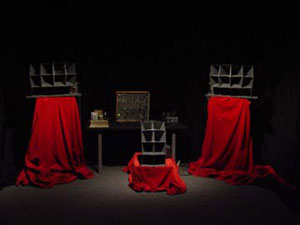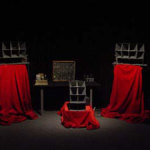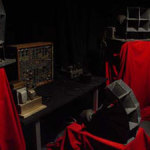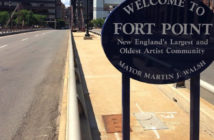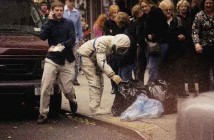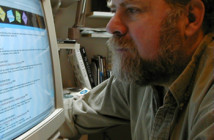Many of the works you do are hand-built electronics made from vintage parts. I’m curious as to how you position your piece historically within an art world that is crushing on new medias of digital sound and image.
JR: People have a hard time classifying my art, because it deals directly with technology, but is clearly not "New Media" in the common use of that term, which seems to pertain exclusively to digital technologies. I am interested in electronics and sound reproduction, and I am also very interested in the history and social context of these technologies. In Society, there's so much focus placed on technology itself, but hardly any on the history. So I feel like I have to keep going back in history, to try to come to terms with where technology has lead us.
One of your piece's primary components are the three Altec-Lansing “Voice of the Theater” speakers dating from the 1940s, which were salvaged from the Coolidge Corner Theater, from which the piece derives its title.
The Altec horns are certainly the most visually striking technological component of the piece. The Altec Company began producing theater speakers in the 1930's, but switched over to military production during the Second World War. The Voice of the Theatre system was introduced in 1947. It used some important refinements developed in the course of the war effort, such as Alnico magnets for the drivers, and higher-grade aluminum for the horns.
The other technological components include two tube amplifiers, a variac, and one of my synthesizers. One of the amplifiers is from an electronic organ from the 1950's. I had to replace some of the tubes with modern reproductions, but otherwise the electronics are all original. The other amplifier is one that I built. All the parts came from different pieces of junk that I cobbled together. It was the first tube amp I built, and I was surprised at how easy it was to get working. In the era of tubes, parts were still fairly general, and they worked together well. It wasn't like now where everything is ultra-specialized and incompatible.
I’m interested in the way Bill Arning curated the exhibition, and how you see
your work in relation to the others included in the show.
All of the pieces are installations based on a combination of sound and light, but not using video. It's an important distinction to make, because we're so used to that combination of moving picture with soundtrack, and none of these pieces has that, with the possible exception of the “Listening Post”, which actually is scripted into a series of scenes that take about forty minutes to play through. Allora and Calzadilla's “Traffic Patterns” is totally minimalist and conceptual, whereas Hansen and Rubin's “Listening Post” is an extremely expensive New Media tromp l'oeil. Bruce Bemis uses obsolete technology in his piece, attempting to recall the historical fragility of our media record, which is similar to what I did. Mittleman and Lislegaard use technology in a different way, as a means to an end, to construct intimate spaces. Lislegaard allows you to see the technology by looking behind a wall, while Mittleman hides it in a secret hallway behind his hallway, but technology seems more incidental to both of them.
Ann Lislegaard’s “Corner” and Hansen & Rubin’s “Listening Post” literally used private and collective voices. How do you see the “voice” within your piece?
In the days of vaudeville, the actors on the stage provided the literal "voice" of the theater, in real time, with their physical presence. With the coming of moving pictures, the actors became disembodied, but the illusion wasn't complete until the coming of the talkies. The attraction of this new media was so great that movie houses in metropolitan areas had upwards of 4000 seats. The "Voice of the Theatre" speaker system was a large part of making that possible - 4000 people simultaneously eavesdropping on a private conversation. Or course, it wasn't a real conversation at all, just a representation of a faux conversation. So to me, the speaker itself seemed like the really important piece of this scenario. The voice was coming from the speaker itself! So in my piece, I wanted to hear that speaker, to unmask the voice. The speaker was meant to stay behind the screen, and I wanted to do away with the screen, to show where the sound was really coming from.
In addition, a microphone is stuck in the left horn's mouth, picking up the sounds it's producing. This signal is reproduced through the right speaker. So there are really two voices you hear at once, the horn's original voice, and a reproduction via the microphone and a second horn.
The human voice is lacking in my piece, but again, there was no human speaking at the movie theater either, just a reproduction. Originally I was going to have the microphone on a stand, picking up things the audience said while they were in the room. But I didn't want to give the audience such a strong voice, going to the movies isn't karaoke! If you speak up at the movies, they kick you out. There's only room for one voice, the voice that comes from behind the screen. And please don't tell me a room full of nerds shouting jokes in unison at corny science fiction movies is a model of participatory cinema!
One thing that struck me about Hansen and Rubin's “Listening Post” was the overtly male, British authoritarian voice, like a BBC anthropology documentary. I thoroughly enjoyed the piece, but after a while I started to distrust the BBC Macintosh voice, even though the piece seems “random”- choices were made and it began to seem like a study. Have they created “The Voice of the Internet”? If it’s some old colonial British guy I’m not comfortable with it!
I'm not sure how or why they arrived at that choice. One of their stated goals for the piece was to provide a capsule version of the Internet's "collective conversation." The internet is worldwide, with many voices speaking in many different languages at once, and a lot of people have high hopes that it will be a positive force for spreading democracy. The use of the authoritarian voice homogenizes these multiple voices, and it does make you wonder. I would like to read it as a critique of the internet's history - the internet came directly out of ARPANET, which was developed expressly for the military, but I'm not sure that's a critique they're offering.
I was also struck by the many public and private places that appeared as an
implied subtext of a couple of pieces. Allora & Calzadilla’s “Traffic Patterns”
and Hansen & Rubin’s “Listening Post” conjure a feeling of a public place, a
crowd, while Mittleman’s “Hallway” and Lislegaard’s “Corner” position themselves in
a domestic, intimate, private place. I see the “Voice of the Theater” a little
bit outside of the direct correlation of placing an audience in a public or
private situation. It seems to be exposing the armature of film, implying an audience, but it lacks bodies.
When you first enter through the red velvet curtains, you think you're really going somewhere, but then you end up in a kind of back-stage area, where the technological apparatus is laid bare. At the same time, the darkened room affords a certain privacy. A group of Boston teens came to see the show. They used my piece as the stage for an impromptu freestyle session, rapping against the horns' clicking. Whereas Lislegaard and Mittleman create very intimate but also isolating spaces, and the Ruben-Hansen piece is very public, I set up a space that was waiting for a public that doesn't arrive.
You have been performing with your hand built synthesizers for some time, using
your electronics within a gallery context is relatively new. Tell me about this
direction in your work. The last six months, you were taking a break from
performance, but now you are about to tour again. What is it about a gallery
audience and a performance audience that you respond to?
My friend Christopher Forgues told me that while he's playing music, he gets to live how he really wants. When I play music, I always feel too aware of the instant, totally living in the moment. I don't feel liberated or confined, just excited but also exposed. My noise performances have always been predicated on taking a big risk. Sometimes it's the last thing I want to do, other times I couldn't think of doing anything else.
In working with installations, everything's different. I get to spend several weeks or months developing a world to live in. I know when I've hit the right combination because I get very comfortable, I can relax and I don't need to work anymore. So I create the installations so that I have somewhere to live the way I want to. Whether the dream world is pleasant or a nightmare, when it stops me from thinking about the rest of the world I know I've really entered somewhere. With the “Voice of the Theatre”, it was strange for me because I worked on it for six months. Every other installation I've done was under a much shorter time frame. “Untitled (for Governor Ryan)” was done in about 10 days, due to a miscommunication. “Red Sky at Night” took about three weeks to realize. So by the time “Voice of the Theatre” opened, I didn't know if I was still in love with it or not. But then I went back two weeks after the opening, and I felt so excited, I ran up to the horn and stuck my head in it. And I realized that the further I stuck my head in, the higher the pitches got. And I also realized that part of what made the sound so complex was that the microphone in the left horn wasn't just picking up the original clicks from the horn, but the clicks were traveling the length of the room, bouncing off the back wall, reentering the horn, and getting picked up a second time. So there were still all kinds of new things to hear, and it was magic for me, and I fell in love all over again.
- Voice of the Theatre, Jessica Rylan, 2004: installation view.
- Voice of the Theatre, Jessica Rylan, 2004: installation detail.
----
Links:
MIT List Visual Arts Center
Berwick Institute for Research
"Son et Lumière" is on display at MIT's List Visual Arts Center from February 12 – April 4, 2004.
All images are courtesy of the artist and MIT's List Visual Arts Center."
Meg Rotzel is the director of the Berwick Research Institute. Her own work has also been featured in numerous exhibitions across the country and abroad.
Jessica Rylan, born in 1974, London, U.K., lives and works in Reading, Mass. She holds a Master of Fine Arts in Music from Bard College and has gained attention in the underground noise music scene. Her sound installation works include Untitled (for Governor Ryan), seen in Boom Box: The Art of Sound, Boston Center for the Arts (2003), Red sky at night, Sailor’s delight. Red sky in the morning, Sailor take warning, the Berwick Research Institute, Roxbury, Mass. (2002), and Untitled (for Oskar Sala), Bard College (2002). Her solo noise performances, using primarily home-made or modified equipment, have been shown in venues such as Oni Gallery, Boston, Mass. (2003), The Roxy, Boston, Mass. (2002), and Berwick Research Institute, Roxbury, Mass. (2002).

